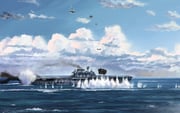battle of santa cruz
The Battle of the Santa Cruz Islands, fought during 25–27 October 1942, sometimes referred to as the Battle of Santa Cruz or Third Battle of Solomon Sea, in Japan as the Battle of the South Pacific (Japanese: 南太平洋海戦 Minamitaiheiyō Kaisen), was the fourth aircraft carrier battle of the Pacific campaign of World War II.
It was also the fourth major naval engagement fought between the United States Navy and the Imperial Japanese Navy during the lengthy and strategically important Guadalcanal campaign. As in the battles of the Coral Sea, Midway, and the Eastern Solomons, the ships of the two adversaries were rarely in sight or gun range of each other. Instead, almost all attacks by both sides were mounted by carrier- or land-based aircraft.
The Japanese ground offensive on Guadalcanal was underway with the Battle for Henderson Field while the naval warships and aircraft from the two adversaries confronted each other on the morning of 26 October 1942, just north of the Santa Cruz Islands. After an exchange of carrier air attacks, Allied surface ships retreated from the battle area with the fleet carrier Hornet sunk, and another fleet carrier, Enterprise, heavily damaged. The participating Japanese carrier forces also retired because of high aircraft and aircrew losses, plus significant damage to the fleet carrier Shōkaku and the light carrier Zuihō.
Santa Cruz was a short-term Pyrrhic victory for the Japanese in terms of ships sunk and damaged, and control of the seas around Guadalcanal. However, Japan's loss of many irreplaceable veteran aircrews proved to be a long-term strategic advantage for the Allies, whose aircrew losses in the battle were relatively low and were quickly replaced. The Japanese had hoped for, and needed, a larger, decisive victory. The fact that the naval battle was won just after the land battle was lost by the Japanese meant that the opportunity to exploit their success in the battle had already passed.



